It’s wonderful to have your home full of furry friends and leafy greens. Adding houseplants to your home décor can be a challenge for many Fur Parents, as some houseplants may be toxic to pets who may choose to nibble on your chosen lush greenery. The good news is that there are many indoor plants that are safe for your pets, whilst also purifying the surrounding air!
Here is our list of 8 cat-friendly plants that are great air purifiers and are safe for your furry friend:
12 CAT-FRIENDLY HOUSEPLANTS THAT PURIFY THE AIR.
- Cast Iron Plant
- Parlor Palm
- Chinese Money Plant
- Calathea Plant Family
- Baby Rubber Plant
- Birds Nest Fern
- Love Palm
- Hoya Plants
- Nerve Plants
- Prayer Plants
- Hairy Stemmed Rhipsalis
- Australian Sword Fern – Emerald Queen
These delightful pet-friendly plants also have air-purifying properties, which will provide you with numerous benefits, from improving your mood to combating the effects of air pollution in your daily life.

CAST IRON PLANT
The Cast Iron Plant (Aspidistra Elaitor) behaves in accordance to its name, that is, as hardy as cast iron metal. A fantastic addition to any décor space, they add a lush tropical touch with their paddle-shaped deep green foliage.
As indoor plants, they are highly adaptable to varying conditions and can live for many years with the most minimal of care. They’ll liven up a cool, low-lit dull corner or passageway, and will look just as striking as a lush floor level plant in a warm well-lit patio setting.
Their large paddle-shaped foliage effectively captures toxins such as harmful Carbon Monoxide from your home. Leaving you with fresh, healthy air while being safe around both cats and dogs.
Cat Care Top Tip: Their foliage can curve downwards at the top, catching the eye of a playful cat. But they are unlikely to cause the plant much harm, as the leaves of mature plants are elongated and should be out of reach. Take note, as slow-growing plants, Cast Iron Plants take a while to recuperate from any lost foliage. Thus, if you have a curious kitty who loves to play, keep it out of reach.
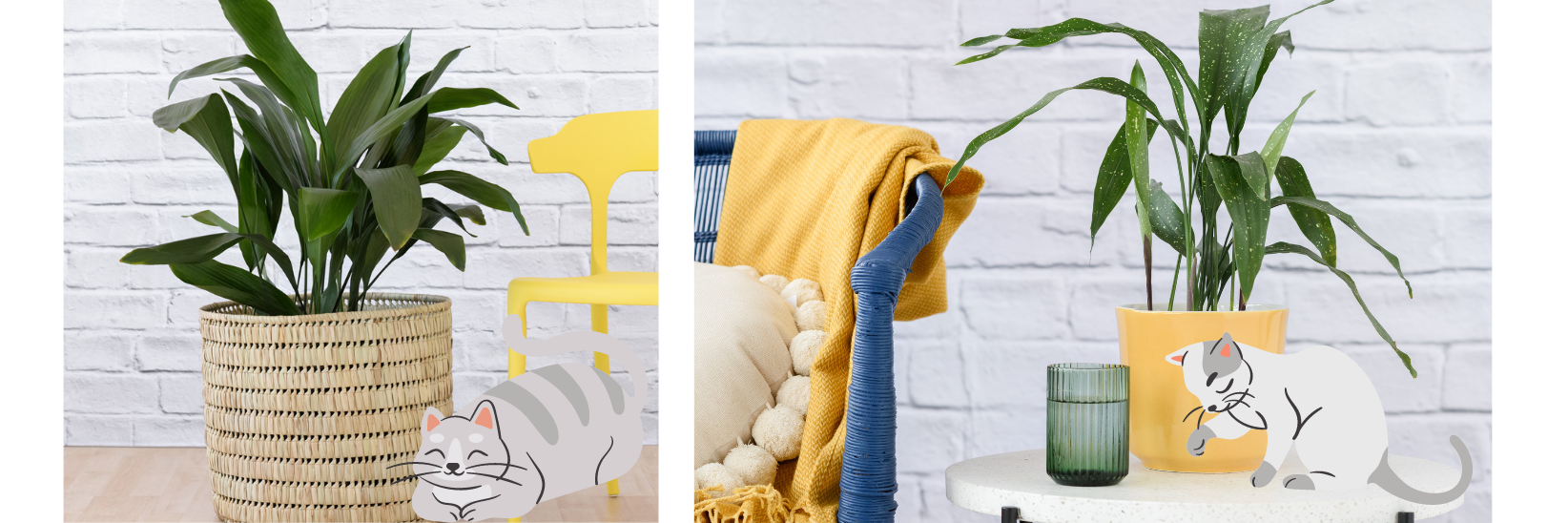
PARLOR PALM
The Parlor Palm (Areca Palm), also often called the Bamboo Palm, is one of the most ubiquitous indoor palms. With its delicate sprays of grass green foliage, this plant adds instant drama to any bright room, whether at home or in the office, out of direct sunlight.
Best of all is their hard-working attitude to removing a variety of toxins from your household air, including Carbon Monoxide, Benzene, Formaldehyde, Trichloroethylene, Xylene, and a whole lot more.
Cat Care Top Tip: Parlor Palms are especially loved by cats, who often view their delicate leaves as their own grass patch to chew on, or in general, an entertaining piece of greenery to play with. Therefore, it’s a huge comfort to know that they are safe around fluffy felines. Besides, they can get pretty big, up to 2 meters tall indoors, making them hard to keep out of reach, yet ideal as a floor-level showpiece.
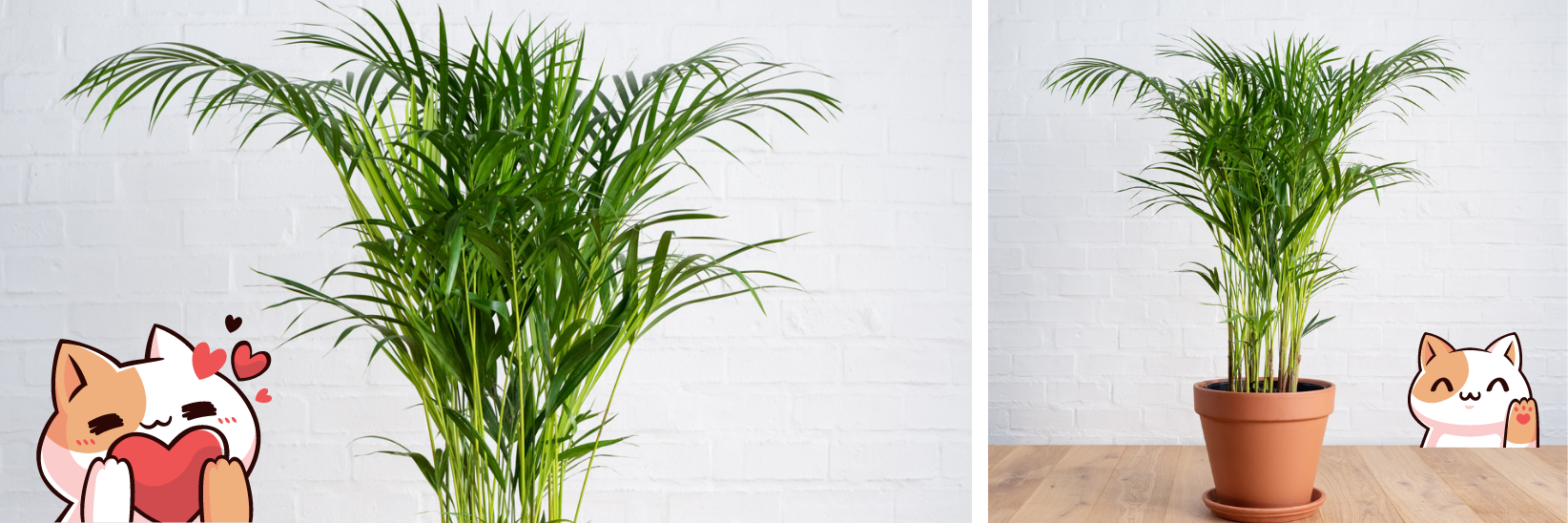
CHINESE MONEY PLANT
Pilea Peperomiodes is one of those much-loved houseplants that truly stand out in a crowd. Their attraction is twofold: beloved for its ease of care and propagation, whilst being uniquely attractive with its green saucer-shaped leaves that seem to float around the plant.
Their ease of care is linked to their slightly succulent foliage. They love to dry out and prefer a bright dappled position, with some soft early or late direct sunlight, which will keep your plant looking full. Especially, if given a quarter turn at every watering, to ensure the plant gets even lighting right around.
The large round flat leaves of the Chinese Money Plant tend to have a few more stomata, the breathing apparatus of a plant, that makes it more efficient at converting Carbon Dioxide into Oxygen, adding yet another benefit of having this fabulous plant in your home: fresh purified air.
Cat Care Top Tip: These leaves can be delicate, and snap off easily, so when it comes to your cat, it is generally a good idea to keep them out of the way on a bright shelf, just to preserve the aesthetic of this delightful plant. Luckily, they’re safe around your cat, so if it does take a nibble, or use it as its own personal plant petter, then your cat will be perfectly fine.
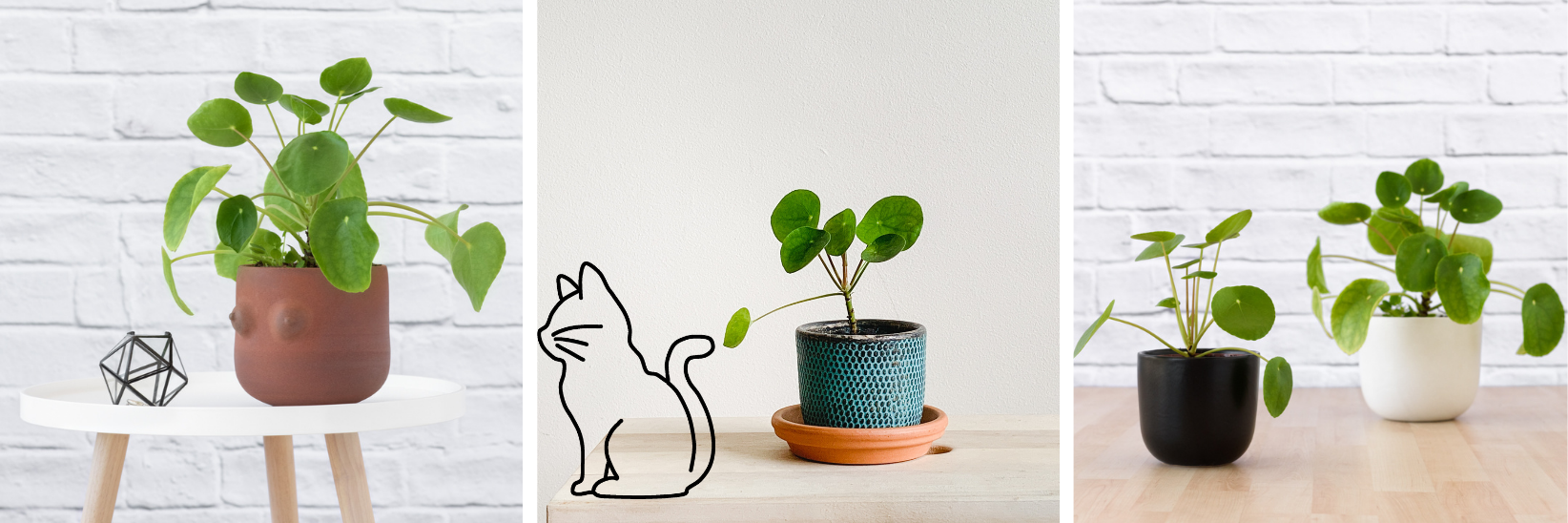
CALATHEA PLANT FAMILY
Calathea Plants are some of the most attractive houseplants, available in a wide range of foliage and leaf shapes. Ideal for adding either a pop of colour or contrast to any indoor décor space or plant collection.
For Calathea to thrive, it needs warmth, medium to bright filtered light, and high humidity. As a result, they do great in a bathroom with plenty of natural light, since the humidity in a bathroom is higher.
Overall, this highly decorative houseplant is a fantastic air purifier and will filter out a large variety of volatile toxins within your home’s air. Leaving you with not only something eye catching to look at but also fresher cleaner air to breathe.
Cat Care Top Tip: The picturesque foliage, the patterned stripes and orbed lines might mesmerize your cat into, pause, stealth, attack! With soft, temptingly responsive foliage, all the more exciting for your furry friend. Consider placing the plant out of reach. Or near cat-phobic water, such as next to your bathtub.
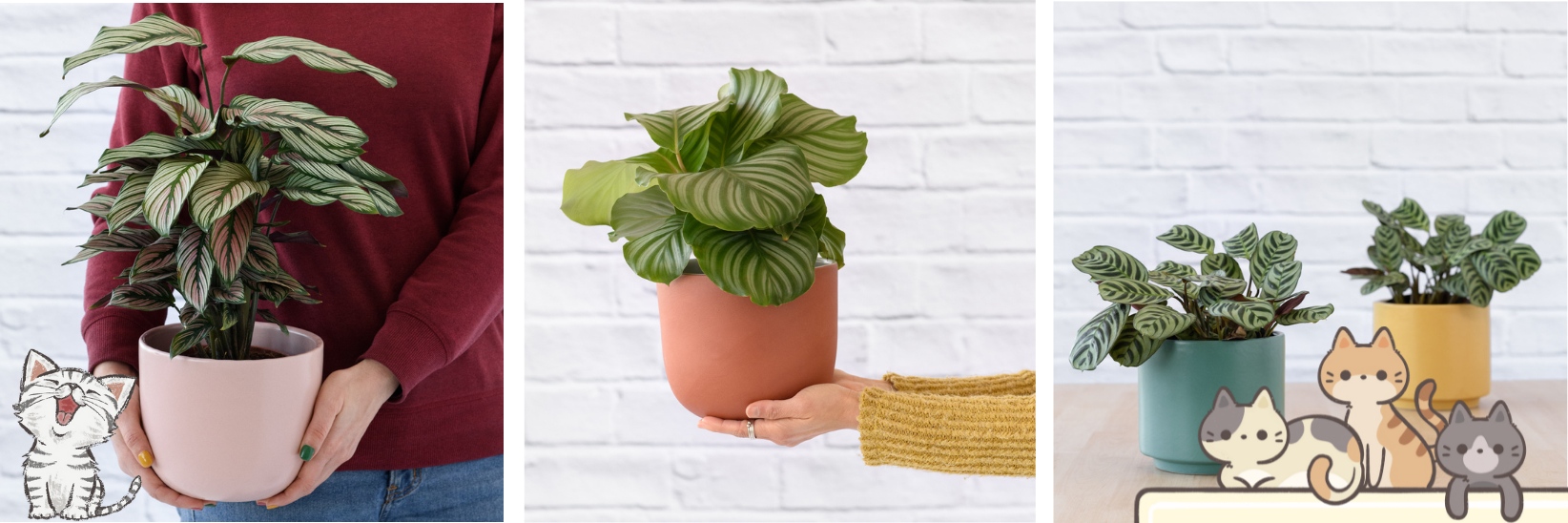
BABY RUBBER PLANT
Peperomia obtusifolia is a tough, evergreen plant, featuring glossy, thick and ovate foliage. The species is highly adaptable too, happily living in bright indirect light or artificial light. Furthermore, due to their semi-succulent nature, they do not require frequent watering.
They come in a stellar variety of colours and patterns, including Marbled, Red Edged and Pixie Variegated. A low-maintenance touch of green for beginners and experts a like.
Baby Rubber Plants are top of the line when it comes to air purification. As per NASA’s Clean Air study, Peperomia as a species can reduce indoor Formaldehyde levels by 47%. Leaving the air you breathe the cleanest and safest it can be.
Cat Care Top Tip: Since they don’t have dangly bits to play with, and aren’t that tasty to bite into (we’re assuming here), you have a lot of latitude for styling your plant – any surface or shelf. Should Felix the Cat take a bite, then consider using the piece to multiply your plant. Read up more on propagating plants here.
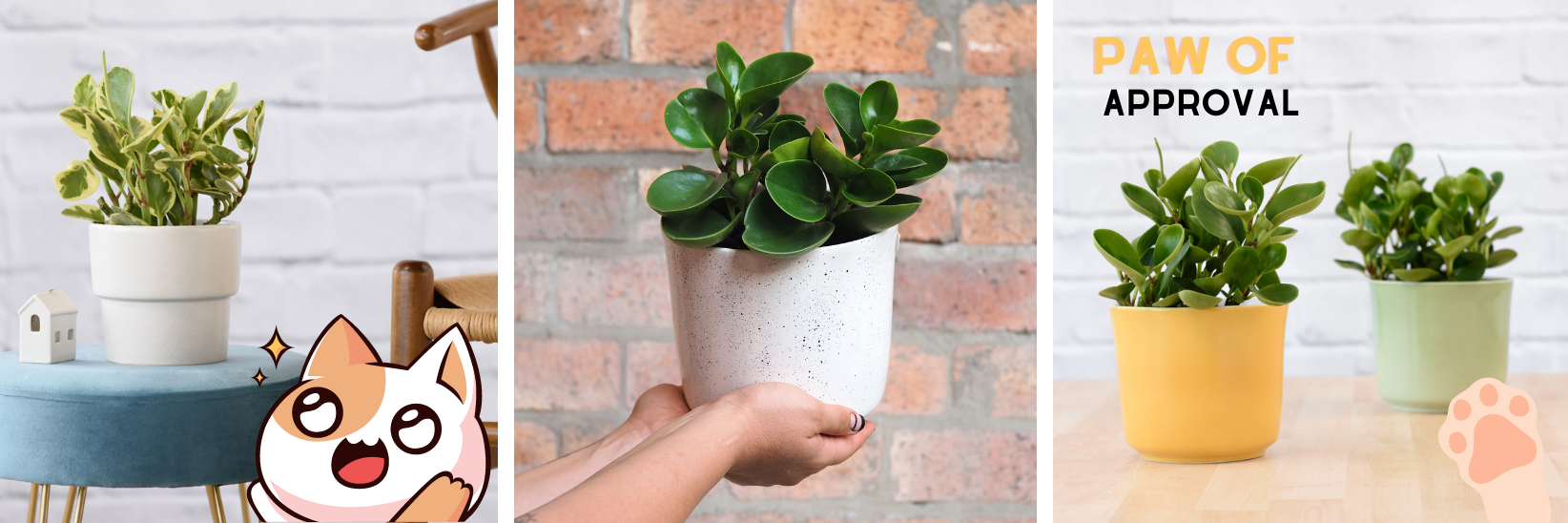
BIRDS NEST FERN
The Birds Nest Fern (Asplenium) tribe is fabulous! There are so many hybrids of this perfect beginner fern, that one could happily collect one of each, and create a fantastic and unique collection of them. Their tender new foliage grows in a rosette form concentrically outwards, hence their distinct common name: looking like a clutch of tiny birds’ eggs in a nest.
Although humidity is beneficial to them, it isn’t absolutely necessary in order for them to look pretty. What is important is regular watering to keep the soil moist and bright indirect light. This beautiful houseplant can be displayed anywhere that’s bright and cosy, whether it’s on a tabletop or as a bathtub adornment.
In Feng Shui, Bird’s Nest Ferns are also believed to deflect Sha, or negative energies in the home. They have other superpowers as well, including the ability to remove household toxins from the air, making it safe for us and our cats to breathe. The fact that they’re non-toxic makes them a winner all around.
Cat Care Top Tip: The curious shape and responsive foliage will probably be interesting for your kitty. Best to keep out of their way. If you are feel daring, then know that any damaged foliage will quickly be replaced with new growth – no sweat.
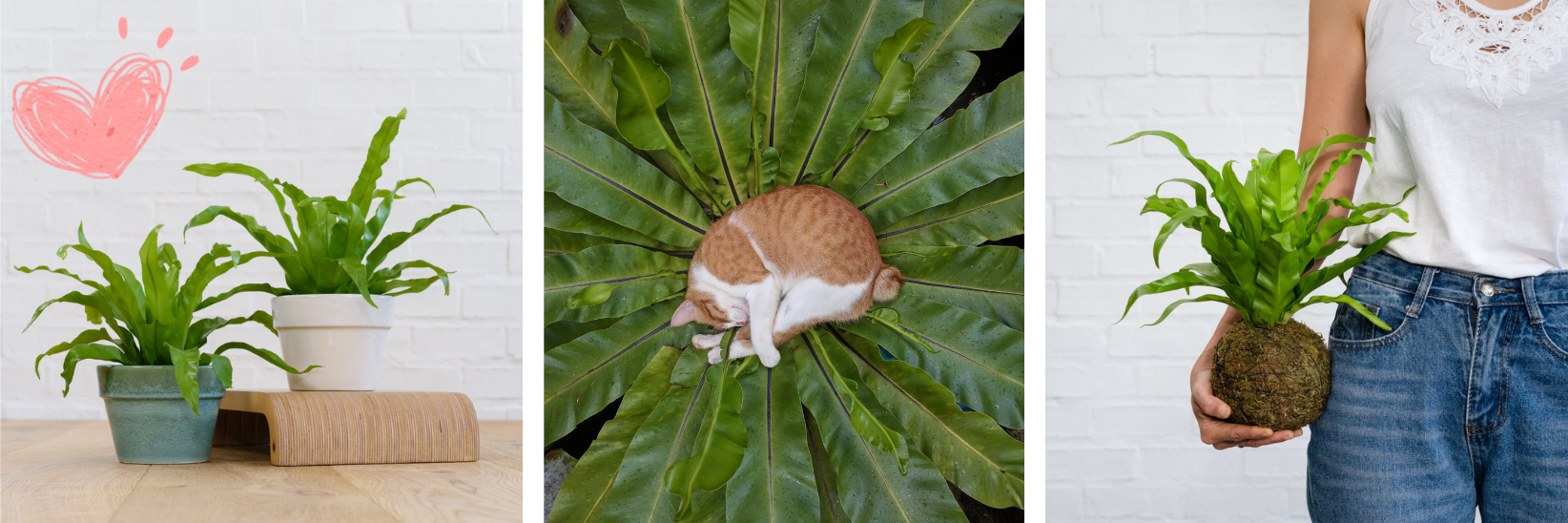
LOVE PALM
The Love Palm, also known as Chamadorea Elegans, has been appreciated for its compact, lush growth habit since the Victorian era. Compared to other palm varieties, Love Palms have a shorter growth habit and only reach 1.5m in height, ideal for compact spaces.
For the best growth, Love Palms prefer bright, filtered light, but can tolerate medium lighting conditions. The plants also require very little watering, as they prefer to let their soil get dry before a drink is needed again.
They have also been named one of the top 10 ideal plants for purifying the air inside homes. Eliminating household toxins such as Formaldehyde, Benzene, and Trichloroethylene. Excellent for creating a fresh jungle feel.
Cat Care Top Tip: Your Cat may take a liking to its fronds, just as it may with the Parlor Palm. Fortunately, they won’t hurt your furry friend, but if they’re eating the leaves, their leaves may look a little tattered. To prevent this, provide your cat with an alternative to chew on, such as Pet Grass or Catnip.
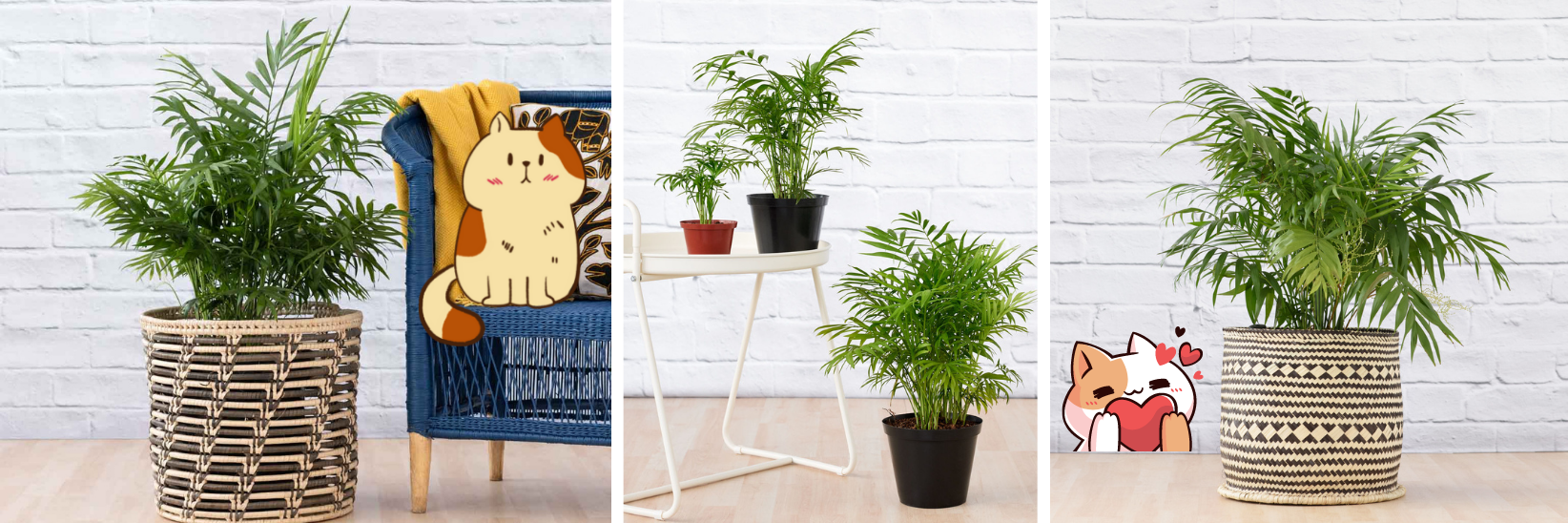
HOYA PLANTS
Hoya is a fabulous species of houseplant. They’re easy to grow and come in a large variety of leaf shapes and patterns. Making it a top collectors plant world over. They’re most loved for their vining habit and gorgeous scented blooms that they produce.
As a fast-growing vine, the Hoya makes for the most elegant hanging specimen or shelf adornment. Trailing gracefully from its planter creating often a full and eye-catching look.
Though these long trails can grab the attention of your cat quite easily, looking very similar to a long string.
As most Hoya specimens are regarded as semi-succulent, one may be tempted to place it in Direct sunlight. Avoid this as Hoya prefer a more filtered light position to really thrive, and avoid turning yellow and bleached looking. This is because in their natural habitats, the warm humid jungles of Asia, they tend to be found creeping through the canopies where light is relatively filtered but still bright. Humidity is also generally important, but not always a must for keeping your plant thriving.
These special vines are also highly effective air purifiers and are able to remove all 5 of the top VOCs (Volatile Organic Compounds) from your home. Leaving you and your Cat with fresher air to breathe.
Cat Care Top Tip: Hoya produces latex (a white sticky substance) when cut or injured, from both their leaves and their stems. This latex can be a skin irritant for both humans and pets. Due to this, it is best to keep your Hoyas high out of the way of your curious cats. Luckily, if they do get hold of it, it’ll do very little harm to them.

NERVE PLANTS
The Nerve Plant (Fittonia) is one of those fabulous filler plants. Great for filling up small gaps or for use as a coffee table staple. They’re beautifully patterned with silver veining and are often also known as the Mosaic Plant. They’re also available in a variety of colours from reds to pinks to greens, a truly fabulous plant.
They’re pretty easy to care for too and are one of those ‘talking plants’. When thirsty, these lovely little houseplants tend to droop dramatically, but give it water, and within an hour they’ll pop up and will act as if nothing happened. This is a great time, to then check if any of your other Plants are ready for a drink.
The Nerve Plant appreciated bright filtered light best, to grow vigorously, though will tolerate lower lighting but will not stay full and bushy.
Not only is the Nerve Plant a pretty filler but like all the plants in this blog, they are fantastic air purifiers. Known to remove the toxin Toulene out of the air. Toluene has a few side effects, but can mainly affect your breathing as it is a respiratory tract irritant. Ultimately, leaving you and your Cat friend with fresher nicer air to breathe.
Cat Care Top Tip: Fittonia are not typically played with by cats, though kittens may be curious and take a nibble or for no apparent reason, knock it off the xounter. In this case, place your Nerve Plants high and out of reach. For the sake of the Plant and your Sanity.
Click for more care info for the Nerve Plant.

PRAYER PLANTS
Prayer Plants (Marantha leuroneura ), like their cousin Calatheas, are truly beautiful. Their striking leaf patterns and dancing foliage make them a wonderful addition to your plant collection. Tricolors are known for their stunning red lines, Lemon and Lime for their deep green foliage surrounded by bright greens, and Kerchoveana for their stunning dark spots. Perfect for matching your interior.
Prayer Plants like similar care to the Calathea, however, we find they are a little hardier. Provide them with good humidity and a medium to bright light position for best results. They tend to develop smaller leaves if their lighting conditions are on the lower side, and this is a good indicator that you may want to change their positioning.
The Prayer Plant is not only a good-looking specimen but has also been rated as one of NASA’s top air purifiers. It has the ability to remove most toxins from the air in 30sq meters of Space. What’s not to love?
Cat Care Top Tip: As with the Calathea, the Prayer plant with its dancing foliage, can be a highly attractive toy for your furry friend. Especially because they tend to grow outward, making it the perfect plant to swat. Place it high out of reach, or use in a spot where your cats are less likely to bother your houseplants, as this one is best appreciated from above.
Click for detailed care for the Prayer Plant.

HAIRY STEMMED RHIPSALIS
The Hairy Stemmed Rhipsalis is a curious Jungle cactus. It has long spindly green to purple leaves covered in fine soft hairs. They’re a quirky-looking Plant that will add texture and intrigue to your hanging display, and if you’re lucky enough, it’ll bloom for you during Spring.
This relatively striking houseplant is also a wonderfully easy care plant. Provide it with bright filtered light to keep it growing quickly and full. You can provide it with some soft early morning sunlight to keep its purple tinge and just to keep the plant happy, though avoid direct sunlight all day. As a Jungle cactus, they love humidity, though it isn’t a must and placing your Rhipsalis in an average room won’t make much of a difference, though keep it well watered. When it comes to watering, the Hairy Stemmed Rhipsalis likes its soil consistently but barely moist. This means just damp enough to feel the moisture but not the soil is not soggy.
The Hairy Stemmed Rhipsalis is what we’d consider a light air purifier, but an air purifier nonetheless. Paired with a bunch of other air purifying plants, this stunner will add to leaving you and your cat with the freshest air possible, as it converts CO2 to Oxygen.
Cat Care Top Tip: As a non-toxic houseplant, the Rhipsalis is a fantastic option in a cat-friendly home. Though we’d recommend hanging it up high and out of the way, as the leaves can easily be knocked off by a passing rub or wispy tail.
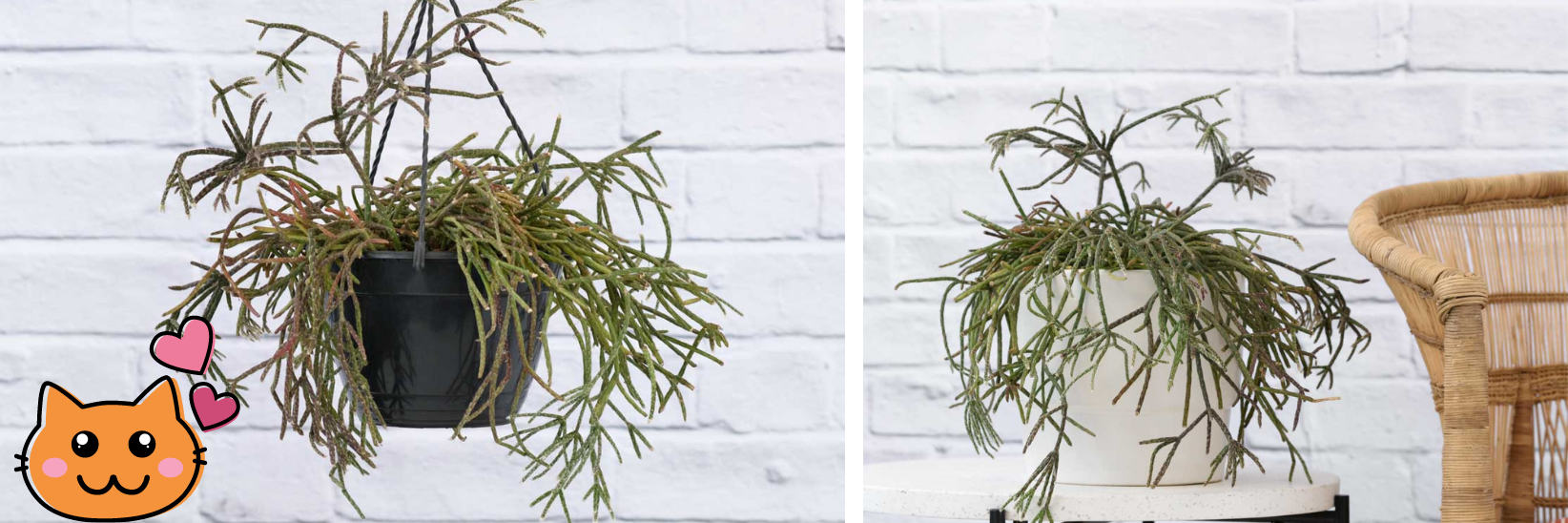
AUSTRALIAN SWORD FERN ‘EMERALD QUEEN’
Any interior space will benefit from adding Ferns, creating a sense of classical elegance. With its long flowing fronds and ease of care, the Australian Sword Fern ‘Emerald Queen’ (Nephrolepis Obliterata Emerald Queen) is an ideal plant for any room.
Ferns love humidity, and medium to bright filtered light best. Thus, if you’re looking for something that’ll liven up your bathroom or kitchen, these will be the perfect houseplants for you.
The Nephrolepis is rated number 9 on NASA’s top 50 air purifying plants, and will happily remove any Formaldehyde, Xylene and Toluene from the air, helping you have cleaner fresher air, and a safe healthy cat.
Cat Care Top Tip: Luckily, Sword Ferns make beautiful hanging baskets or striking shelf decorations. Great for keeping out of reach of curious kitties, who will possibly use the fronds as a replacement for a mouse on a string toy. Fortunately, even if they got too close to them, they’re known to be safe for pets. So, an all-around near-perfect houseplant.
For an alternative to the Sword Fern, consider the Macho Fern – just as air purifying and safe for your cat.

TOP TIP: If your cat is eating your houseplants, which is especially true for indoor cats, you may want to consider providing some Pet Grass or Wheat Grass to them, and encouraging them to eat that instead. For the same reasons as other animals, cats eat grass or other plants to get more fibre into their diet. This helps aid with digestion and improves their gut health.
Being a Fur Parent comes with some restrictions, but living in a lush, thriving urban oasis shouldn’t be one of them. Our list of pet-friendly options will allow you to create the space of your dreams for you and your beloved pets, whilst also freshening up your home’s air.
Click here for more PET FRIENDLY Plant options.

